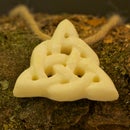Introduction: Modify a Cheap USB Charger to Feed an IPod, IPhone or Samsung Galaxy
A couple of years ago I got an iPod touch as a gift and I decided to buy a USB charger for it. So I bought a really cheap one but it never worked. The iPod, once connected, did not like it and did not want to charge. Since it was so cheap I just let it sit in a drawer forgetting about it.
A little while ago then I stumbled on this very good article: http://www.ladyada.net/make/mintyboost/icharge.html
In which they decribe how they produced a battery powered USB charger. After reading that article I took my cheap USB charger and decided to modify it.
This will be a really, really easy modification and I think that anybody with a soldering iron could do it.
A little while ago then I stumbled on this very good article: http://www.ladyada.net/make/mintyboost/icharge.html
In which they decribe how they produced a battery powered USB charger. After reading that article I took my cheap USB charger and decided to modify it.
This will be a really, really easy modification and I think that anybody with a soldering iron could do it.
Step 1: A Little Theory
A USB connector has 4 pins: +V, D-, D+, GND. The +V pin with the GND give the +5 V that aliments the phone; while the D- and D+ pins are used for communications. Old USB electronic devices did not care about D+/- pins as long as the other two did give nourishment.
Nowadays the iPhone expects a certain voltage on those two pins to decide how much current to absorb from the charger. Putting a 2.0 V voltage on both the pins the iPhone will absorb about 500 mA, while with 2.8 V on D- and 2.0 V on D+ it will absorb about 1000 mA.
The same behaviour I expected to be observed on my iPod.
On the images there are the schemes for the two configurations. As you can see, using an opportune couple of resistors it is possible to get the voltage required. Obviously the 1000 mA configuration is better if you want your phone charged quicker, but it is possible that your power supply can not support that much current.
Nowadays the iPhone expects a certain voltage on those two pins to decide how much current to absorb from the charger. Putting a 2.0 V voltage on both the pins the iPhone will absorb about 500 mA, while with 2.8 V on D- and 2.0 V on D+ it will absorb about 1000 mA.
The same behaviour I expected to be observed on my iPod.
On the images there are the schemes for the two configurations. As you can see, using an opportune couple of resistors it is possible to get the voltage required. Obviously the 1000 mA configuration is better if you want your phone charged quicker, but it is possible that your power supply can not support that much current.
Step 2: Opening and Checking
To see if the data pins of my USB charges were at the wrong voltage, I used a hobby knife to open the plastic case.
The cases were glued together so I had to break open them. The Car USB chargher, though, had the top that was screwed on.
I was happy to find fuses inside the two: my iPod should be safe!
As you can see on the pictures the data pins are floating and that is why my iPod did not want to charge.
The specifications of the stickers on the items say that the wall plug can provide no more that 500 mA while the car charger no more than 1000 mA. I decided to stick to 500 mA for both of them.
The cases were glued together so I had to break open them. The Car USB chargher, though, had the top that was screwed on.
I was happy to find fuses inside the two: my iPod should be safe!
As you can see on the pictures the data pins are floating and that is why my iPod did not want to charge.
The specifications of the stickers on the items say that the wall plug can provide no more that 500 mA while the car charger no more than 1000 mA. I decided to stick to 500 mA for both of them.
Step 3: Resistors
I needed a couple of resistors that could give me a 2.0 V out of 5.0 V. The ones that I chose are: 220 Ohm and 330 Ohm.
Both the pins should be at the same voltage thus only 2 pairs of resistors are needed.
Both the pins should be at the same voltage thus only 2 pairs of resistors are needed.
Step 4: Drilling Holes
I drilled 4 holes on the wall plug board with my Dremel for my resistors. The holes are near the USB pins to make the soldering easier.
The car charger has pleny of space so I did not need to drill holes.
The car charger has pleny of space so I did not need to drill holes.
Step 5: Soldering
I then added the new resistors to the boards. I short-circuited the data pins with a little bit of solder, since I wanted both of them at 2.0 V. Unfortunately I am not a very skilled solderer, as you can see on the car charger pictures.
Step 6: Checking
When I finished the soldering I checked all the connections with a multimeter. Then I plugged the chargers and checked if the tension was good. I managed to get about 2.1 V on both of them. This was a really dangerous step because I had them powered and uncovered, touching them could lead to injuries.
Step 7: Testing
I then tested the chargers on my iPod, Samsung Galaxy and on some friends' iPods. They seem to charge just fine and do not complain.
While charging the Samsung Galaxy, though, the charger got really hot. I am not sure if it is good or not, since I have never used it without my "fix". I should measure the current that the Galaxy drains, to see if it is in the parameters of the charger.
My conclusion is that: It Works!
While charging the Samsung Galaxy, though, the charger got really hot. I am not sure if it is good or not, since I have never used it without my "fix". I should measure the current that the Galaxy drains, to see if it is in the parameters of the charger.
My conclusion is that: It Works!





